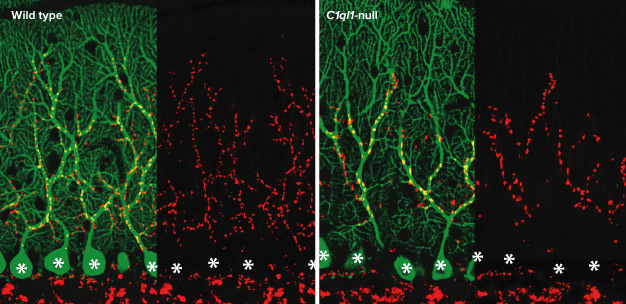A protein pair manages the proper development of neuronal connections essential for motor learning and neurological health
Published online 6 August 2015

Climbing fibers form numerous synapses (red) with Purkinje cells (green; asterisks indicate cell bodies) in the cerebellum of normal, wild-type, mice (left). In mice lacking the protein C1ql1 (right), climbing fibers form a greatly reduced number of synapses with Purkinje cells.
Reprinted from Ref. 1, Copyright 2015, with permission from Elsevier
A mechanism that controls the formation and elimination of neuronal connections in the brain's motor center, the cerebellum, has been discovered by researchers led by Michisuke Yuzaki and Wataru Kakegawa at Keio University1. The process remains active over the course of a lifetime, and may be associated with certain neurological disorders.
Voluntary movement in the cerebellum is governed by signals transmitted at synaptic junctions between climbing fibers and neurons called Purkinje cells. "In immature animals, each Purkinje cell is innervated by numerous climbing fibers," says Kakegawa. "But as the animal grows, one climbing fiber ― referred to as the winner ― is strengthened, and the remaining weak climbing fibers are gradually eliminated." Kakegawa and Yuzaki identified a protein that might control this 'pruning', and set out to test their hypothesis.
They generated genetically modified mice lacking the protein known as C1ql1, which is specifically produced by climbing fibers. Purkinje cells in these mice retained multiple climbing fiber connections, but failed to establish the formal synaptic linkages needed for normal signaling (see image). In contrast, mice producing high levels of C1ql1 initially established excess connections, but pruned these down to a single winner within days. "This suggests that C1ql1 contributes to the strengthening of winner climbing fibers and the elimination of excess weak climbing fibers during development," says Kakegawa.
Subsequent experiments revealed that C1ql1 establishes fully functional climbing fiber-Purkinje cell synapses by binding a receptor protein called Bai3. The effects of Bai3 deficiency were essentially indistinguishable from those seen in mice lacking C1ql1, generating disruptions in synapse formation that interfered with the capacity to learn motor skills. The climbing fiber pruning process normally initiates roughly a week after birth, but the researchers were surprised to discover that the signals remain active throughout adulthood. Experiments that prevented C1ql1-Bai3 interaction in genetically normal adult mice undid the pruning process, resulting in impaired motor learning. However, the researchers could restore normal connectivity in adult mice that grew up lacking C1ql1 or Bai3 by enabling production of these proteins.
Kakegawa believes that these findings may offer important insights into human health. "Synapse dysfunctions have been observed in mouse models of psychiatric disease and in individuals with neurological disorders," he says. "Furthermore, the Bai proteins have been associated with psychiatric symptoms." A top priority for Yuzaki's team will be to explore this signaling pathway and to learn whether these proteins and their relatives perform similar roles elsewhere in the brain.
Reference
- Kakegawa, W. et al. Anterograde C1ql1 signaling is required in order to determine and maintain a single-winner climbing fiber in the mouse cerebellum. Neuron 85, 316-329 (2015). | article